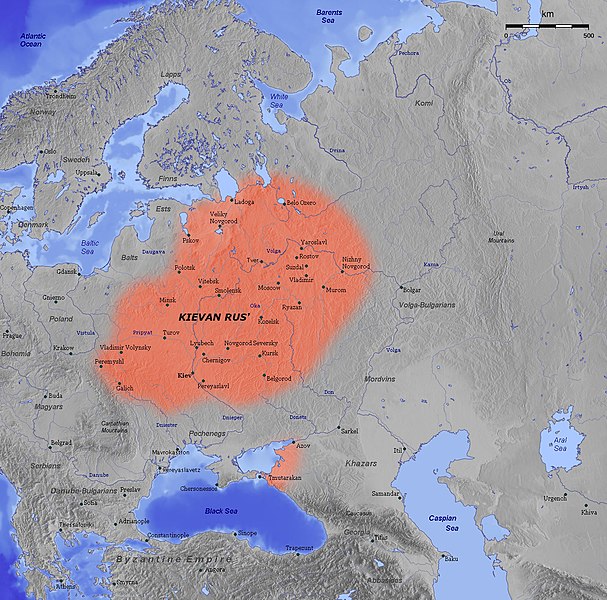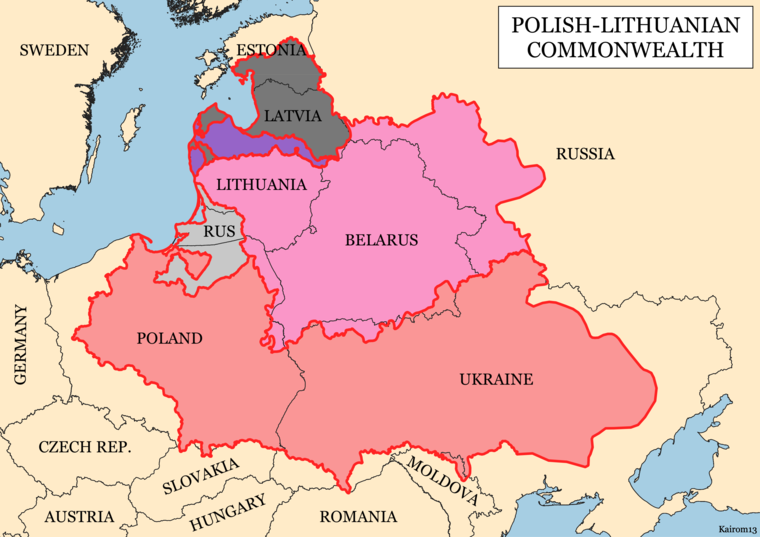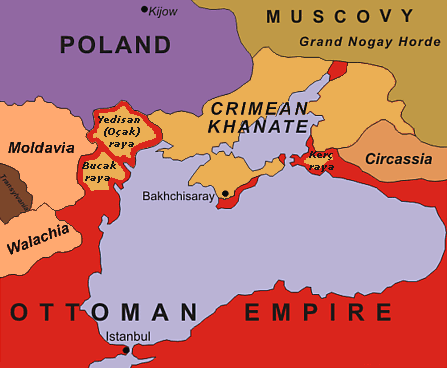
Map of the Kievan Rus' in the 11th century. During the Golden Age of Kiev, the lands of Rus' covered much of present day Ukraine, Belarus, and western Russia.

In the centuries following the Mongol invasion, much of Ukraine was controlled by Lithuania (from the 14th century on) and since the Union of Lublin (1569) by Poland, as seen at this outline of the Polish-Lithuanian Commonwealth as of 1619.

The Khanate of Crimea was one of the strongest powers in Eastern Europe until the end of the 17th century.
The Ruin
In 1657-1686 came "The Ruin," a devastating
30-year war between Russia, Poland, Turks and Cossacks for control of Ukraine. For three years Khmelnytsky's armies controlled present-day western and central Ukraine, but deserted by his Tatar allies, he suffered a crushing defeat at Berestechko, and turned to the Russian Czar for help. In 1654, Khmelnytsky signed the Treaty of Pereiaslav, forming a military and political alliance with Russia that acknowledged loyalty to the Czar. The wars escalated in intensity with hundreds of thousands of deaths.
Defeat came in 1686 as the "Eternal Peace" between Russia and Poland gave Kiev and the Cossack lands east of the Dnieper over to Russian rule and the Ukrainian lands west of the Dnieper to Poland. In 1709 Cossack Hetman Ivan Mazepa (1687-1709) sided with Sweden against Russia in the Great Northern War (1700-1721).
Mazepa, a member of the Cossack nobility, received an excellent education abroad and proved to be a brilliant political and military leader enjoying good relations with the Romanov dynasty. After Peter the Great became czar, Mazepa as hetman gave him more than twenty years of loyal military and diplomatic service and was well rewarded. Eventually Peter recognized that in order to consolidate and modernize Russia's political and economic power it was necessary to do away with the hetmanate and Ukrainian and Cossack aspirations to autonomy.
Peter refused to assist Cossack forces in protecting Ukraine from imminent attack by Sweden, thus abrogating treaty obligations between Russia and Ukraine. Mazepa accepted Polish invitations to join the Poles and Swedes against Russia. The move was disastrous for the hetmanate, Ukrainian autonomy, and Mazepa. He died in exile after fleeing from the Battle of Poltava (1709), where the Swedes and their Cossack allies suffered a catastrophic defeat at the hands of Peter's Russian forces.
The hetmanate was abolished in 1764; the Zaporizhska Sich abolished in 1775, as centralized Russian control became the norm.
With the partitioning of Poland in 1772, 1793, and 1795, the Ukrainian lands west of the Dnieper were divided between
Russia and
Austria. From 1737 to 1834 expansion into the northern Black Sea littoral and the eastern Danube valley was a cornerstone of Russian foreign policy.
Ukraine entered World War I on the side of both the Central Powers, under Austria, and the Triple Entente, under Russia. 3.5 million Ukrainians fought with the
Imperial Russian Army, while 250,000 fought for the
Austro-Hungarian Army.
Inter-war Polish Ukraine
The war in Ukraine continued for another two years; by 1921, however, most of Ukraine had been taken over by the
Soviet Union, while Galicia and Volhynia were incorporated into independent
Poland.
A powerful underground Ukrainian nationalist movement rose in Poland in the 1920s and 1930s, led by the Ukrainian Military Organization and the Organization of Ukrainian Nationalists (OUN). The movement attracted a militant following among students and harassed the Polish authorities. Legal Ukrainian parties, the Ukrainian Catholic Church, an active press, and a business sector also flourished in Poland. Economic conditions improved in the 1920s, but the region suffered from the Great Depression in the 1930s.
Inter-war Soviet Ukraine
The revolution that brought the Soviet government to power devastated Ukraine. It left over 1.5 million people dead and hundreds of thousands homeless. The Soviet Ukraine had to face the famine of 1921.[28]
Moscow encouraged a national renaissance in literature and the arts, under the aegis of the Ukrainization policy pursued by the national Communist leadership of Mykola Skrypnyk (1872-1933). Seeing the exhausted society, the Soviet government remained very flexible during the 1920s.[29] Thus, the Ukrainian culture and language enjoyed a revival, as Ukrainisation became a local implementation of the Soviet-wide Korenisation (literally indigenisation) policy.[27] The Bolsheviks were also committed to introducing universal health care, education and social-security benefits, as well as the right to work and housing.[30] Women's rights were greatly increased through new laws aimed to wipe away centuries-old inequalities.[31] Most of these policies were sharply reversed by the early 1930s after Joseph Stalin gradually consolidated power to become the de facto communist party leader and a dictator of the Soviet Union.
The communists gave a privileged position to manual labor, the largest class in the cities, where Russians dominated. The typical worker was more attached to class identity than to ethnicity. Although there were incidents of ethnic friction among workers (in addition to Ukrainians and Russians there were Poles, Germans, Jews, and others in the Ukrainian workforce), industrial laborers had already adopted Russian culture and language to a significant extent. Workers whose ethnicity was Ukrainian were not attracted to campaigns of Ukrainianization or de-Russification in meaningful numbers, but remained loyal members of the Soviet working class. There was no significant antagonism between workers identifying themselves as Ukrainian or Russian; however, anti-Semitism was widespread.
Following the Invasion of Poland in September 1939, German and Soviet troops divided the territory of Poland. Thus, Eastern Galicia and Volhynia with their Ukrainian population became reunited with the rest of Ukraine.
The unification that Ukraine achieved for the first time in its history was a decisive event in the history of the nation.
fonte:
http://en.wikipedia.org/wiki/Ukraine
--------------
Não admira que existam tantas rivalidades internas, dado que o Leste e o Ocidente da Ucrânia praticamente viveram sempre de costas voltadas um para o outro, envolvidos em conflitos e partilhas territoriais!![Fogo! [004]](./images/smilies/004.gif) Se a Ucrânia continuar neste ritimo vai acabar se fragmentando e a parte oriental junto com a Criméia voltam para a Rússia.
Se a Ucrânia continuar neste ritimo vai acabar se fragmentando e a parte oriental junto com a Criméia voltam para a Rússia. 





